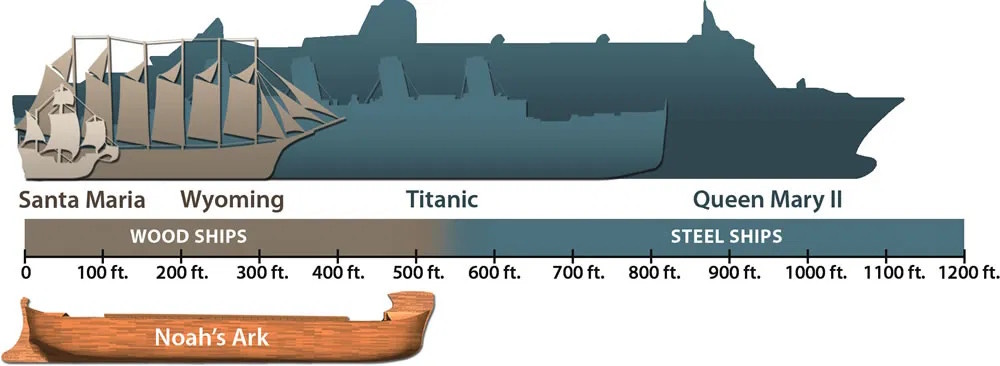Noah's Ark (That Boat Don't Float!)
Unknown
Introduction
It is claimed that Noah's Ark was able to sail through a 40-day storm more intense than any ever previously seen, indeed hundreds of times stronger, on this planet yet human ingenuity has been unable to reproduce anything similar with the kinds of building materials available to people at that time. This article, by an unknown author, compares the ark to the USS Wyoming, a steel braced, wood-gulled schooner half again smaller than the supposed ark.
Discussion
In 1898 the U.S.S. Wyoming was launched. She was the state-of-the art in wooden hulled shipbuilding. She was a six masted schooner and, at 329 ft., the longest ship with an all-wood keel and hull ever built. She was one of nine six masted schooners build around the turn of the century. All were 300 ft. or more in length. They were all state-of-the art.

 It is said that she could be seen to snake (movement of the bow from side to side in relation to the stern) and hog (movement of the bow up and down in relation to the stern) while underway. The action of the waves, in even calm seas, caused the planking to be sprung beyond the capabilities of any caulking that could be devised. The Wyoming (and all eight of her sister ships) were considered unseaworthy. They were used for short (too long under way and the leakage became more than the pumps could handle), close-in coastal hauls, generally in sight of land. At the first sign if inclement weather, they were required to run for port (any port in a storm).
I have always had a great love for windjammers. I have some very expensive books that deal with the minutia of their construction and for years my hobby was to build full rigged wooden models. I spent hours climbing over the decks of the U.S.S. Constitution in Charleston Navy Yard, admiring her construction. The Wyoming must have been a beautiful vessel. But she was a beautiful anachronism. At about 300 ft. the structural capabilities of wood were exceeded beyond the abilities of engineering and design to remedy. After the Wyoming and her sisters, wood was abandoned as construction material for major vessels.
And yet, creationists want me to believe that a 450 ft. (minimum) vessel of ALL wood construction was able to withstand a storm of 40 days and then remain at sea for almost a year, manned by only eight people, without the efficient steel pumps of the turn of the century, caulked with nothing more than "pitch inside and out". Not to mention the overwhelming necessity of the limited crew to feed and water thousands of animals and to muck out thousands of cages (and then carry the result of the mucking up two decks in order to throw it overboard). When was there time for pumping (24 hours a day as indicated above) and the constant recaulking in a futile attempt to stem the flow.
It is said that she could be seen to snake (movement of the bow from side to side in relation to the stern) and hog (movement of the bow up and down in relation to the stern) while underway. The action of the waves, in even calm seas, caused the planking to be sprung beyond the capabilities of any caulking that could be devised. The Wyoming (and all eight of her sister ships) were considered unseaworthy. They were used for short (too long under way and the leakage became more than the pumps could handle), close-in coastal hauls, generally in sight of land. At the first sign if inclement weather, they were required to run for port (any port in a storm).
I have always had a great love for windjammers. I have some very expensive books that deal with the minutia of their construction and for years my hobby was to build full rigged wooden models. I spent hours climbing over the decks of the U.S.S. Constitution in Charleston Navy Yard, admiring her construction. The Wyoming must have been a beautiful vessel. But she was a beautiful anachronism. At about 300 ft. the structural capabilities of wood were exceeded beyond the abilities of engineering and design to remedy. After the Wyoming and her sisters, wood was abandoned as construction material for major vessels.
And yet, creationists want me to believe that a 450 ft. (minimum) vessel of ALL wood construction was able to withstand a storm of 40 days and then remain at sea for almost a year, manned by only eight people, without the efficient steel pumps of the turn of the century, caulked with nothing more than "pitch inside and out". Not to mention the overwhelming necessity of the limited crew to feed and water thousands of animals and to muck out thousands of cages (and then carry the result of the mucking up two decks in order to throw it overboard). When was there time for pumping (24 hours a day as indicated above) and the constant recaulking in a futile attempt to stem the flow.
Conclusion
You may perceive this as an argument from incredulity similar to those that are so typical of creationists, but I just can't believe such a fairy tale. Experience with real wooden ships sailing in real oceans indicates that Noah's ark would not have survived many days of the 40-day storm.
My opinion of Noah's ark is that that boat don't float!